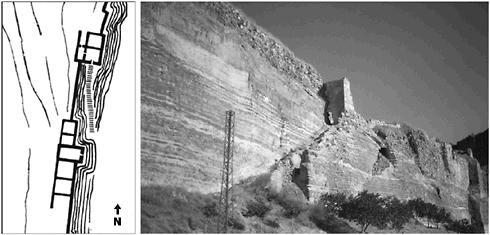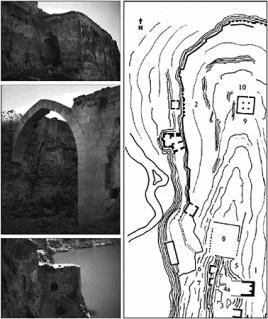Muslim Fortresses in the Levant: Between Crusaders and Mongols (108 page)
Read Muslim Fortresses in the Levant: Between Crusaders and Mongols Online
Authors: Kate Raphael
Tags: #Arts & Photography, #Architecture, #Buildings, #History, #Middle East, #Egypt, #Politics & Social Sciences, #Social Sciences, #Human Geography, #Building Types & Styles, #World, #Medieval, #Humanities

When Lawrence visited the site he entered on foot, crossing the Merzuman on some stepping stones. In speaking of crossing this tributary Lawrence mentions the remains of a collapsed stone bridge.
on foot, crossing the Merzuman on some stepping stones. In speaking of crossing this tributary Lawrence mentions the remains of a collapsed stone bridge.
264
This bought him to the main entrance located on the west, which is hidden and better protected. Thee were altogether three bridges along this tributary; two are dated to the medieval period and one to the Roman (
Figure 4.42
). The main entrance is composed of fie individual gates built along the upper part of the slope. Boase mentions an Armenian inscription flanked by a pair of Seleucid lions (?) above the first gate.
265
Multiple gate systems are not common in Muslim military architecture and even among the Franks and Armenians they are seldom used. A similar gate structure can be seen at Lampron, an Armenian fortress in the northwest of Cilicia, though most of the gate structure

Figure 4.47 , Armenian and Mamluk arrow slits
, Armenian and Mamluk arrow slits

Figure 4.48 , the eastern gate
, the eastern gate

Figure 4.49 , carved and built entrances along the multiple gate system
, carved and built entrances along the multiple gate system
has been dated by Edwards to the Byzantine period.
266
Crac des Chevaliers’ main entrance is constructed on the same principle, though on a much grander scale.
Of the five gates that compose the main entrance at , some are built while others are cut out of the side of the cliff (
, some are built while others are cut out of the side of the cliff (
Figure 4.49
). One moved between the gates via a covered passage that was partly built and partly quarried. The gates are fairly wide large enough for carts and mounted men to enter. The second gate-house could accommodate a small guard of up to five men (judging from the number of arrow slits). Wooden doors were fitted in the rock archways, as is attested by the round sockets for the door hinges; this meant that each gate-house and passage could be bolted and act as an independent unit.
It was usually the topography, in this case the steepness, of the site that dictated such a complex gate system. Its main advantages were the difficulties it presented to
an advancing enemy, which would be halted several times before reaching the fortress grounds. Perhaps this was taken into account during the Mamluk attack of 1292, since the siege report does not mention that the gate was targeted by the army. The Mamluk soldiers eventually entered the fortress by climbing the walls up a long chain tied to the bed rock.
267
Water sources
Whereas at al-Bīra it was difficult to find the remains of wells or cisterns, at the whole fortress seems to have depended on a central well that reached the river. It was a large, almost bell-shaped structure with a spiral staircase cut along the wall leading down to the water. The water supply was not only plentiful but thee was no danger that it would be sabotaged by a besieging army using any of the following methods:
the whole fortress seems to have depended on a central well that reached the river. It was a large, almost bell-shaped structure with a spiral staircase cut along the wall leading down to the water. The water supply was not only plentiful but thee was no danger that it would be sabotaged by a besieging army using any of the following methods:
The Jihadists … are also permitted to cut water canals and destroy water supplies to prevent the from using them. Poison, blood, or any other material that may spoil the drinking water may be thrown into water supplies or canals in order to force the enemy to capitulate.
from using them. Poison, blood, or any other material that may spoil the drinking water may be thrown into water supplies or canals in order to force the enemy to capitulate.
268
In addition to this well a cistern was dug at the northern edge of the spur (
Figure 4.49
, 10).
269
Water was obviously not a great worry.
Buildings along the upper spur of the fortress
The southern fortified complex is built at the highest point within the fortress grounds. One can still see the remains of the Armenian patriarchal church that the Mamluks probably converted into a mosque (
Figure 4.49
, 4a). The caved crosses were removed and two animal figures, possibly panthers, were carved below them. A wall and two towers were built on the western side where the slope is moderate. A second Armenian church lay north of the spur; Sinclair thinks it may have served as a palace during the Mamluk period, but Lawrence suggests it was a mosque.
270
Governor’s quarters often included a small private mosque. It seems this model was followed also at .
.